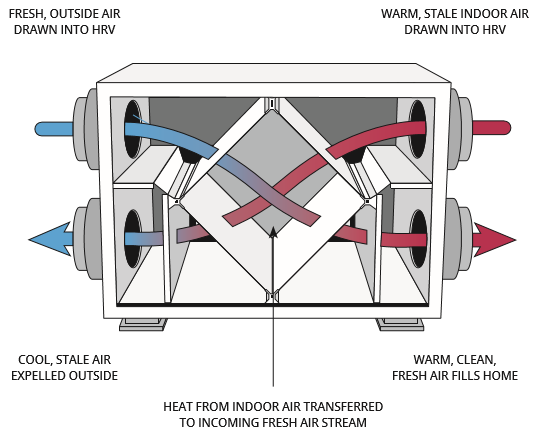The All-Inclusive Overview to the Uses of Heat Recovery Ventilation in Modern Buildings
Heat Recovery Ventilation (HRV) systems represent a substantial improvement in constructing modern technology (HRV Heat Recovery Ventilation). They offer a method for trading stagnant interior air with fresh exterior air while decreasing power loss. This method not just improves indoor air high quality but likewise adds to power effectiveness in both property and business structures. Comprehending the various applications and advantages of HRV can reveal its critical function in contemporary style and sustainability initiatives. The implications of this technology are worth exploring better
Comprehending Heat Recovery Ventilation Solutions

Numerous contemporary structures focus on energy efficiency, comprehending warm recuperation air flow (HRV) systems is vital for maximizing interior air top quality and lowering energy consumption. HRV systems function by transferring warm from stale indoor air to inbound fresh air, effectively maintaining comfortable indoor temperature levels while reducing power loss. These systems contain a warm exchanger, followers, and ductwork that facilitate the flow of air. Throughout winter, HRV units capture and reuse heat from the outgoing air, while in summer, they can help cool inbound air. By constantly trading air, HRV systems additionally lower moisture and the focus of interior contaminants. Appropriate setup and maintenance of HRV systems are necessary for their performance and performance in boosting general structure performance and comfort.
Benefits of Heat Recovery Ventilation
Heat recovery ventilation systems offer numerous benefits that enhance both energy efficiency and indoor air top quality in modern structures. By capturing and recycling energy from exhaust air, these systems greatly lower heating and air conditioning costs, leading to lower energy intake. They preserve a steady circulation of fresh outdoor air, decreasing the danger of indoor air toxins and allergens. This continual exchange aids regulate moisture levels, preventing mold and mildew growth and making certain a healthier living setting. Furthermore, HRV systems add to sustainability objectives by decreasing general carbon footprints. Their capability to maximize ventilation without sacrificing thermal convenience makes them a valuable enhancement to contemporary structure design, advertising both financial and environmental advantages.
Applications of HRV in Residential Buildings
As homeowners progressively focus on energy efficiency and interior air top quality, the applications of heat recuperation air flow (HRV) systems in domestic structures have actually become a lot more widespread. HRV systems are company website especially beneficial in securely secured homes, where preserving fresh air circulation is crucial for preventing wetness build-up and interior pollutants. They effectively move warm from outgoing stagnant air to incoming fresh air, reducing energy prices related to cooling and heating. In addition, HRVs can boost convenience degrees by regulating moisture and temperature. They are also versatile for various property layouts, including single-family homes and multi-unit buildings. Overall, incorporating HRV systems supports lasting living practices while making sure a healthier indoor setting for occupants.
HRV in Business and Industrial Settings
In business and commercial setups, the application of heat recovery air flow (HRV) systems has become increasingly critical for optimizing energy effectiveness and maintaining air high quality. These systems successfully move warm from exhaust air to incoming fresh air, decreasing the need for additional home heating or air conditioning. This not only lowers energy prices but also adds to sustainability campaigns. Industries such as manufacturing, warehousing, and office structures profit considerably from HRV systems, as they assist control temperature and moisture degrees, making sure a comfortable and productive setting. HRV systems help in eliminating contaminants and excess dampness, enhancing indoor air quality. As regulations around air top quality end up being stricter, the fostering of HRV innovation is likely to expand, making it a critical part of contemporary business and industrial infrastructure.
Future Fads in Heat Recovery Ventilation Technology

Often Asked Concerns
How Does Heat Recovery Ventilation Impact Indoor Air Quality?
Heat recovery ventilation significantly improves indoor air quality by continuously exchanging stagnant interior air with fresh exterior air while recouping power. This Find Out More process lowers toxins, preserves optimal humidity levels, and assures a much healthier atmosphere for passengers.
Can HRV Solutions Be Installed in Existing Structures?
HRV systems can without a doubt be set up in existing buildings. Retrofitting may call for adjustments to ductwork and ventilation layouts, however it substantially boosts energy efficiency and interior air high quality, making it a practical alternative for older frameworks.
What Maintenance Is Needed for HRV Equipments?

Exist Particular Climates Where HRV Is A Lot More Efficient?
Heat recovery ventilation systems are specifically reliable in environments with considerable temperature level distinctions between periods. These systems optimize energy efficiency by recovering heat from exhaust air, making them suitable for both chilly and reasonably cozy environments.
Just How Do HRV Solutions Affect Energy Costs?
